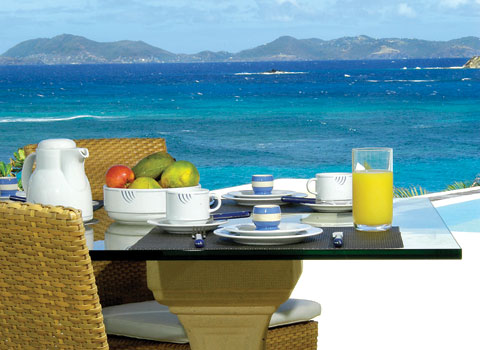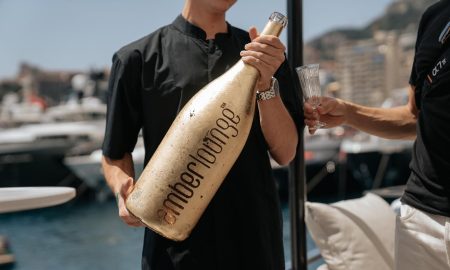Where the well-heeled trade in their Louboutins for sandals.
By Monique Stringfellow
n addition to his residential creations, Messel designed a hotel-the Cotton House.
Though modern-day Mustique embodies barefoot elegance, its earlier days were more barefoot than elegant. The island’s history began in 1958, when 28-year-old Lord Glenconner, the Honorable Colin Tennant, was sent to the Caribbean to look after the family estates. Caught by the island’s charm, he decided to sell the family’s Trinidadian plantations and purchase the land. Tennant paid $67,500 for the island, which he christened Mustique. The island’s name is a derivative of the Creole word for mosquito-fitting for the 1,400 acres of undeveloped, dense shrub.
Today, many elite figures have made headlines with the purchase of a private island, but at the time, Tennant was a pioneer of luxurious living. But this was not at the forefront of Tennant’s goals; he was merely looking for a place where he and his friends could pass the gray English winters.
Tennant’s connections within British society proved useful to the organic development of Mustique. The wedding of Princess Margaret was a major turning point for the island. Tennant gifted her with a villa on 10 acres of land, which sealed the island’s status as a 1960s hotspot. All eyes were on Mustique the day that the Royal Yacht Britannia disembarked at its makeshift harbor. Dinner parties at Les Jolies Eaux, Princess Margaret’s estate, became the most sought after invitation during the winter season. Mustique’s following included a diverse mix of society, artists, and celebrities, who welcomed one another at their villas. Since air travel was still a novelty, most people could not afford to do it often, and so the Mustique crowd was dubbed as the “jet set.”
Through total coincidence, Princess Margaret’s husband, Lord Snowdon, happened to be the nephew of Oliver Messel-London’s renowned stage designer. Tennant hired Messel as the island’s resident architect and designer, who brought his theatrically trained eye to the outfitting of Mustique’s illustrious homes. His signature green-trellised gingerbread houses are each distinct but follow an aesthetic cohesion, which is simultaneously aristocratic, English, and distinctly Caribbean. Architects and designers working on the island today are often asked to emulate the Oliver Messel touch in their creations.
In addition to his residential creations, Messel designed a hotel-the Cotton House. Instead of using traditionally luxurious materials such as marble and silk, he opted for bamboo and raffia, which maintained the hotel’s Caribbean theme throughout its 17 rooms. Mustique fever was catching on as a steady stream of boldfaced names commissioned private villas. By 1976, there were 75 properties on the island. Because its popularity grew by word-of-mouth, Mustique formed the ultimate VIP list; ownership of a villa became the velvet rope to society. In 1968, the Mustique Company, founded at the peak of the island’s popularity, made a pact with the government of St. Vincent. This partnership ensured that there would never be more than 110 villas on Mustique. Driven by environmental concerns and a desire to limit the maximum population, the agreement sealed Mustique’s exclusivity. The island’s greatest charms are still its rustic appearance and uncrowded beaches.
Tennant’s Mustique Company is still around today, although its founder sold the majority of his shares and moved to St. Lucia some years ago. The island maintains its policy on development, and there are currently less than 100 villas and only six are in the first stages of construction. The Cotton House remains the island’s only hotel and is home to Tuesday-night cocktails in its Great Room-Mustique’s quintessential social event. First-time visitors mingle with third-generation villa owners and are not deterred by anything; come rain, shine, or hurricane season, Tuesday nights are spent in the Great Room. Newcomers are often impressed with Mustique’s welcoming nature; a common sentiment deems the island more like a house party than a resort.
Basil’s Bar, which celebrates its 40th anniversary this year, is the only restaurant on the island. But there is also a bakery and a food market, which provides the necessities for Mustique’s traditional barbeques and cocktail parties. It’s a quaint island for its sophisticated list of visitors. Daily activities include the island’s nine beaches; the most popular is the oddly named Macaroni Beach. There are also equestrian and hiking trails, or sailing for the water enthusiasts, who can unwind at the Cotton House spa after roughing it on the beach.
The latest generation of jet setters is flocking to Mustique during the cold winter months. Its enduring popularity is partly due to its isolated location. New York socialites, British aristocracy and a slew of personalities return year after year. Last winter, Prince William and Prince Harry visited Basil’s Bar where they drank the same punch served on the same veranda as their aunts and uncles did 40 years before. The balmy breeze and pastel-colored vistas are also seductive to Mustique’s stream of visitors. Tommy Hilfiger owns a villa on the island and Tory Burch cites her vacations on Mustique as a major source of inspiration for her consistently colorful line. Despite the illustrious guestbook and multi-million dollar homes, the atmosphere is paparazzi-free and the closest thing to a dress code is an even tan. Therein lies the island’s mystique.























